Envision Algebra 1 Assessment Readiness Workbook Chapter 2
Page 32 Exercise 1 Answer
It is given that there are five numbers.
a. \(\frac{3}{4}\)
b. √9
c. √12
d. −9
e. √20
It is required to determine all the irrational numbers.
Consider √12. Its value is 2√3 . √3 is an irrational number, hence √12 = 2√3 is an irrational number.
Consider √20. Its value is 2√5 . √5 is an irrational number, hence √20 = 2√5 is an irrational number
Consider \(\frac{3}{4}\). It is a ratio of two integers and hence is a rational number, by definition of rational numbers.
Consider √9. Its value is 3, a rational number.
Consider −9. It is a negative integer and hence a rational number.
Thus option c and option e are irrational numbers.
The correct answer is options c and e, representing irrational numbers √12 and √20.

Page 32 Exercise 2 Answer
It is given that the expression is \(\frac{(7)^{-5}(2)^5}{(7)^4(2)^{-2}}\).
a. \(\frac{7^{11}}{2^7}\)
b. \(\frac{7^{9}}{2^3}\)
c. \(\frac{2^{7}}{7^9}\)
d. \(\frac{2^{3}}{7^1}\)
It is required to determine the option that represents the value of the expression using a positive exponent.
Explanation for the correct option:
Option c represents the correct answer.
Consider the given expression
\(\frac{(7)^{-5}(2)^5}{(7)^4(2)^{-2}}\).
The expression can be written in positive exponent using the law of exponent \(.a^{-n}=\frac{1}{a^n}\).
The exponent obtained after applying the law of exponent is \(\frac{(2)^{2}(2)^5}{(7)^4(7)^{5}}\).
Apply the law of exponent ap.aq = ap+q and simplify, \(\frac{(2)^7}{(7)^9}\).
Explanation for other options:
Options a, b, and d do not represent the correct answer because on simplifying, the result obtained is different.
The correct answer is option c, which represents the expression \(\frac{(7)^{-5}(2)^5}{(7)^4(2)^{-2}}\) in terms of positive exponent \(\frac{(2)^7}{(7)^9}\).
Envision Algebra 1 Chapter 2 Answer Key
Envision Algebra 1 Assessment Readiness Workbook Student Edition Chapter 2 Page 32 Exercise 3 Answer
It is given that the equation is ∣2x−4∣ + 2 = 16. The set of possible solutions is given.
a. −5
b. −4
c. −2
d. 5
e. 9
It is required to determine all possible solutions of the given equation among the given values.
Consider the given equation ∣2x−4∣ + 2 = 16. Subtract both sides by 2 and the simplified equation obtained is ∣2x−4∣ = 14
The solutions of the absolute value are given by the equations 2x − 4 = 14 and 2x − 4 = −14
The value of x is determined from the first equation 2x − 4 = 14, by adding both sides by 4 and then dividing by 2 is 9, given by option e.
The value of x determined from the second equation 2x − 4 = −14, by adding both sides by 4 and then dividing by 2 is −5, given by option a.
Hence the solution of ∣2x−4∣ + 2 = 16 is −5, 9, given by options a and e.
On simplifying the given equation ∣2x−4∣ + 2 = 16 the possible solution set does not match options b, c, d.
The correct answer is option a and e, which represent the solution of the equation ∣2x−4∣ + 2 = 16.
Page 32 Exercise 4 Answer
It is given that a line is perpendicular to another line. The other line passes through the two points (1,0) and (3,−4). Options are given among which one represents the equation of a line perpendicular to the line passing through two points (1,0) and (3,−4).
a. y = 2x + 2
b. y = \(-\frac{1}{2} x+2\)
c. y = 2x + 2
d. y = \(\frac{1}{2} x+2\)
It is required to determine the equation of the line perpendicular to the line passing through two points (1,0) and (3,−4) among the given options.
Option d represents the equation of the line perpendicular to the line passing through two points (1,0) and (3,−4) among the given options. Consider the slope of the line passing through the points (x1,y1) as (1,0) and (x2,y2) as (3,−4). It is given by the formula m = \(\frac{y_2-y_1}{x_2-x_1}\). On substitution the slope is given by \(\frac{-4-0}{3-1}\)
Hence slope of the line through the points (x1, y1) as (1,0) and (x2, y2) as (3, -4) is \(\frac{-4}{2}\) = -2.
The slope of perpendicular lines is negative reciprocals of each other. Hence, the slope of a line perpendicular to the line passing through the points (1,0) and (3,−4) is the negative reciprocal of the slope of −2, that is \(\frac{1}{2}\).
The equation of a line with slope m is y = mx + c with c as the y-intercept. In the given options equation of the line having slope \(\frac{1}{2}\) is y = \(\frac{1}{2} x+2\), that is option d.
The equation formed by a line passing through points (1,0) and (3,−4) does not match options a, b, and c.
The correct answer is option d. y = \(\frac{1}{2} x+2\) is the equation of the line perpendicular to the line passing through two points (1,0) and (3,-4).
Envision Algebra 1 Assessment Readiness Workbook Student Edition Chapter 2 Page 32 Exercise 5 Answer
It is given that the amount of saving after working x hours is given by equation y = 9.5x + 25.
It is required to determine earnings per hour.
Consider the equation for the amount of savings after working x hours, y = 9.5x + 25.
In this equation, the constant 25 represents a fixed amount possibly in the form bonus, some initial payment, or initial saving.
Th.5x represents the amount earned when worked for x hours.
Hence the earning per hour, that is for x as 1, is 9.5 × 1 = 9.5.
The earning per hour is 9.5 as determined from the equation y = 9.5x + 25 which represents the amount of savings after working x hours.
Page 32 Exercise 6 Answer
It is given that the expression is (3×44y2)3.
The four options are given.
a. 3x7y5
b. 3x2y
c. 9x12y6
d. 27x12y6
It is required to determine the option that represents the simplified value of the given expression.
Explanation for the correct option:
The correct answer is represented by option d.
Consider the given expression (3x4y2)3.
The expression can be simplified using the law of exponent (an)m = an.m
The exponent obtained after applying the law of exponent is 27x4.3y2.3 = 27x12y6.
Option d is the option that represents the correct answer.
Explanation for other options:
The options a, b, and c do not represent the correct answer because the simplified equation does not match the result.
The correct answer is option d, which represents the expression (3x4y2)3 in a simplified manner 27x12y6.
Envision Algebra 1 Assessment Readiness Workbook Student Edition Chapter 2 Page 33 Exercise 7 Answer
It is given that the function f(x) = |2x – 3|. The options are given a piecewise function out of which one has the same graph as that of f(x).
a. g(x) = \(\left\{\begin{array}{l}
2 x-3, \text { if } x \geq 0 \\
-2 x+3, \text { if } x<0
\end{array}\right.\)
b. g(x) = \(\left\{\begin{array}{l}
-2 x+3, \text { if } x \geq \frac{2}{3} \\
2 x-3, \text { if } x<\frac{2}{3}
\end{array}\right.\)
c. g(x) = \(\left\{\begin{array}{l}
2 x-3, \text { if } x \geq \frac{3}{2} \\
-2 x+3, \text { if } x<\frac{3}{2}
\end{array}\right.\)
d. g(x) = \(\left\{\begin{array}{l}
2 x-3, \text { if } x \geq 0 \\
2 x+3, \text { if } x<0
\end{array}\right.\)
It is required to determine the piecewise function that has the same graph as f(x).
Explanation for the correct option:
Option c represents a piecewise function that has the same graph as f(x).
Consider f(x) = ∣2x−3∣. The function can be given as two piecewise functions
f1(x) = 2x − 3 and
f2(x) = −(2x−3)
f2(x) = −2x + 3.
The range of the piecewise function can be given by the value of x as determined when y is 0.
From f1(x), 2x − 3 = 0, the value of x is obtained by adding 3 on both sides and dividing both sides by 2, the value of x is \(\frac{3}{2}\).
From f2(x), −2x + 3 = 0, the value of x is obtained by subtracting 3 on both sides and dividing both sides by −2, the value of x is \(\frac{3}{2}\).
The function is 2x−3, with x ≥ \(\frac{3}{2}\).
The function is -2x + 3, with x < \(\frac{3}{2}\).
The function is represented by a piecewise function in option c.
As the functions are the same they have the same graph.
The result obtained when function f(x) = ∣2x−3∣ is simplified does not match options a, b, and d.
The correct option that has the same graph as f(x) = ∣2x−3∣ is given by option c.
Page 33 Exercise 8 Answer
It is given that the function is f(x) = 2x + 5. The given options name different types of equations.
a. exponential
b. linear
c. quadratic
d. none of the above
It is required to determine the equation type of f(x).
The correct answer is option b, linear.
Consider the given equation f(x) = 2x + 5.
The equation is in single independent variable x with power 1.
Hence, the equation f(x) = 2x + 5 represents a linear equation, by definition of linear equation.
An exponential equation is an equation in which the independent variable is an exponent of a constant base.
A quadratic equation is an equation with the highest order of independent variables as 2. In standard form, the quadratic equation is y = ax2+ bx + c.
The correct option is b. The equation f(x) = 2x + 5 is a linear equation.
Envision Algebra 1 Assessment Readiness Workbook Student Edition Chapter 2 Page 33 Exercise 9 Answer
It is given that the scores on the first four tests in one class are 88, 97, 89, 78. The required average score for five tests is 90.
It is required to determine the score to be earned in the fifth test to have an average score of 90.
To determine the score to be earned in the fifth test to have an average score of 90, consider the given scores of four tests and denote the required fifth score as x. Determine the value of x using the formula for average with 5 values,
Average = \(\frac{\text { sum of values }}{\text { number of values }} .\)
Assume the score of the fifth test to be x.
The average of the five test scores is given by the formula Average = \(\frac{\text { sum of values }}{\text { number of values }}.\)
⇒ \(\begin{aligned}
& \text { Average }=\frac{\text { Sum of values }}{\text { number of values }} \\
& 90=\frac{88+97+89+78+x}{5}
\end{aligned}\)
Determine the score of the fifth test x
⇒ \(\begin{aligned}
& 90=\frac{88+97+89+78+x}{5} \\
& 90=\frac{352+x}{5}
\end{aligned}\)
Multiply both sides by 5 and simplify
450=352+x
subtract both sides by 352
450-352=352-352+x
x=98
The score required in the fifth test is 98.
The score to be earned in the fifth test to have an average score of 90 is 98.
Page 33 Exercise 11 Answer
Given: Scatter plot.
It is required to estimate an equation of a line that best fits the given scatter plot.
For this, draw a straight line on the given scatter plot then find the values for m and c from the graph and substitute it in the equation of the straight line.
Draw a straight line that passes through the maximum number of points of a given scatter plot.
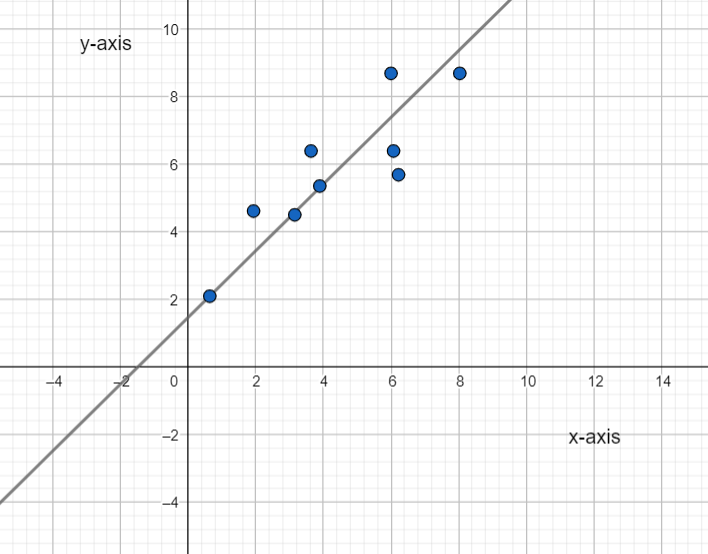
All the points in the given plot lie between the positive x-axis and the positive y-axis, so the slope of the line is positive. Also, the angle of inclination of the slope with the positive x-axis is less than 90º and the y-intercept is approx 2.
Therefore,
m = 1
c = 2
Substitute 1 for m and 2 for c in the equation y = mx + c.
y = x + 2
Option a represents the line with y-intercept as 3 thus the line moves away from the points.
Option b represents the line with a negative slope so it cannot be the best-fitted line.
Option d represents the line with a negative slope so it cannot be the best-fitted line.
An equation of a line that best fits the given scatter plot is y = x + 2.
Option (C) is correct.
Page 33 Exercise 12 Answer
In the question, the given series is \(\frac{1}{2}\),√7,−√2,−2,\(\frac{3}{4}\),3.
It is required to arrange the given numbers in order from least to greatest.
For this, first, convert the given numbers into integers and then compare them.
Convert numbers other than -2 and 3 into integers
⇒ \(\begin{aligned}
\frac{1}{2} & =0.5 \\
\sqrt{7} & =2.6 \\
-\sqrt{2} & =-1.41 \\
\frac{3}{4} & =0.75
\end{aligned}\)
0.5,2.6-141,0.75
Compare numbers and arrange them in ascending order
-2<-1.41<0.5<0.75<2.6<3
\(-2<-\sqrt{2}<\frac{1}{2}<\frac{3}{4}<\sqrt{7}<3\)
Compare numbers and arrange them in ascending order
The required arrangement of numbers is given as -2 < -√2 < \(\frac{1}{2}\) < \(\frac{3}{4}\) < √7 < 3
Envision Algebra 1 Assessment Readiness Workbook Chapter 2 Solutions
Page 34 Exercise 13 Answer
Given data shown in the dot plot to the nearest hundredth.
It is required to find the mean and median for the given data and tell the reason behind the different values of mean and median.
To find the mean and median it is required to extract data from the given dot plot, then find the mean and the median of the given data using the formula mentioned in the tip section.
Extract and compare information from the given dot plot.
6,6,6,6,7,7,7,7,7,8,8,10,11
Total number of observations is 13.
Substitute required values in the formula,
⇒ \(\begin{aligned}
& \text { Mean }=\frac{\text { Sum of observations }}{\text { total number of observations }} \\
& \text { Mean }=\frac{6+6+6+6+7+7+7+7+7+8+8+10+11}{13}
\end{aligned}\)
Mean =\(\frac{96}{13}\)
Mean =7.38
Here, n is an odd number
Substitute 13 for n in the formula
Median =\(\left(\frac{n+1}{2}\right)^{\text {th }} \text { term }\)
Median = \(\left(\frac{13+1}{2}\right)^{\text {th }} \text { term }\)
Median
Both the values are different because the mean is the average of given numbers and the median is the middle term.
Envision Algebra 1 Assessment Readiness Workbook Student Edition Chapter 2 Page 34 Exercise 14 Answer
Given that the area of the rectangle is 6x2 + 8x + 2 and the length of the rectangle is 3x + 1.
It is required to find the width of the rectangle.
To find the width of the rectangle, substitute the given values in the formula given in the tip section. Factorize the numerator part and then solve it.
Substitute 6x2 + 8x + 2 for A and 3x + 1 for l in formula A = l × b and simplify.
Given 6x²+8x+2 and the length of the rectangle is 3x+1
A=lxb
Substitute A=6x²+8x+2 and l=3x+1
(3x+1)b=6x²+8x+2
⇒ \(b=\frac{6 x^2+8 x+2}{3 x+1}\)
Factorize the numerator of equation \(b=\frac{6 x^2+8 x+2}{3 x+1}\)
⇒ \(b=\frac{2 x(3 x+1)+2(3 x+1)}{3 x+1}\)
⇒ \(b=\frac{(2 x+2)(3 x+1)}{(3 x+1)}\)
b=2(x+1)
The required value of the width of the rectangle is 2(x+1).
Page 34 Exercise 15 Answer
In the question, the given inequality is 2x + 3y > 12.
It is required to graph the inequality 2x + 3y > 12.
To graph the inequality 2x + 3y > 12, it is required to plot the graph for 2x + 3y = 12 and then compare the points above and below the line
2x + 3y = 12 and shade the region in which the point satisfies the given inequality.
Plot the graph for 2x + 3y = 12.
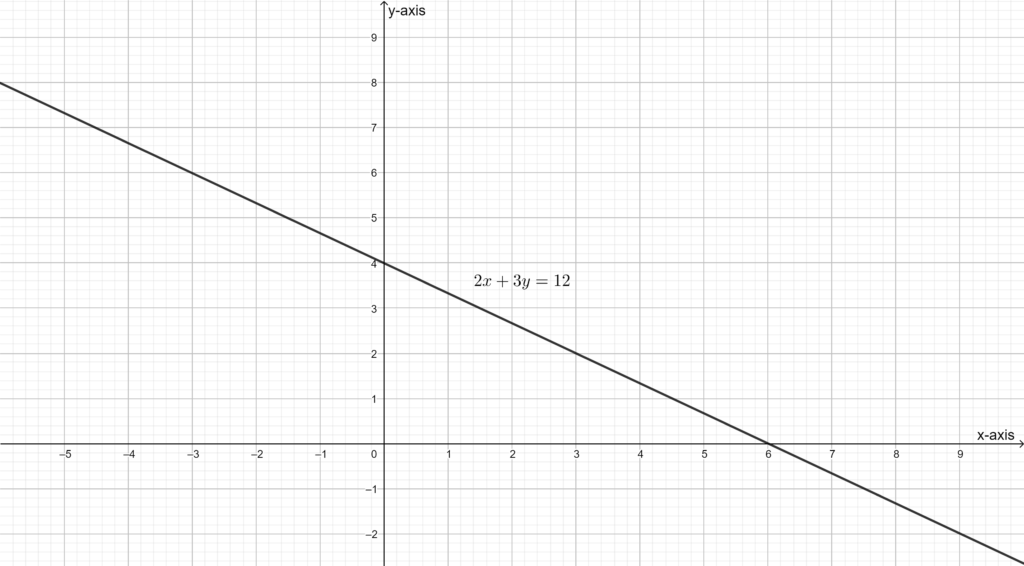
Plot points (1,2) and (3,4) in the graph 2x + 3y = 12 and check the given inequality for both points.
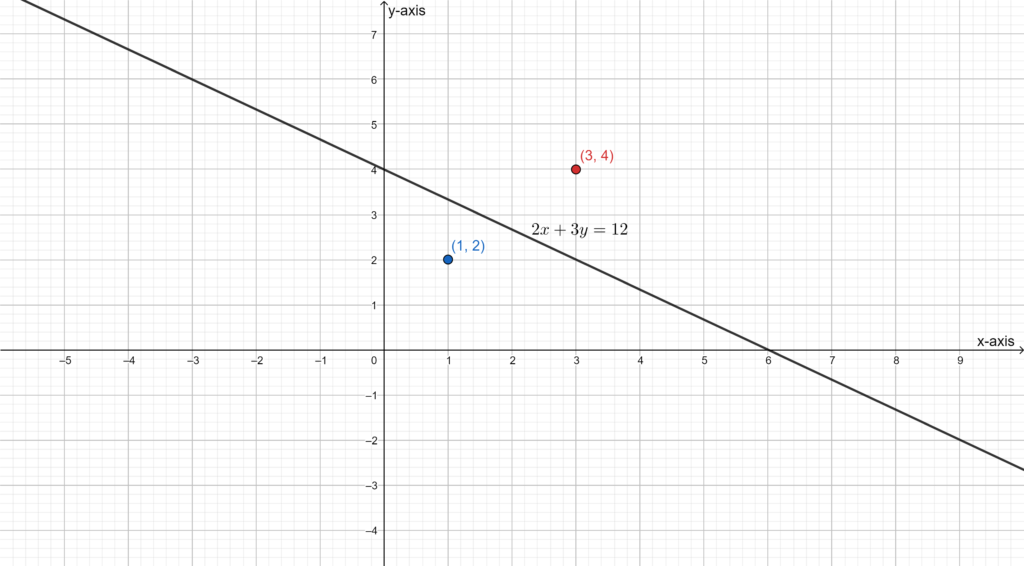
For (1,2)
2(1) + 3(2) = 8 < 12
For (3,4)
2(3) + 3(4) = 18 ≥ 12
Shade the region in the graph which satisfies the inequality 2x + 3y > 12.
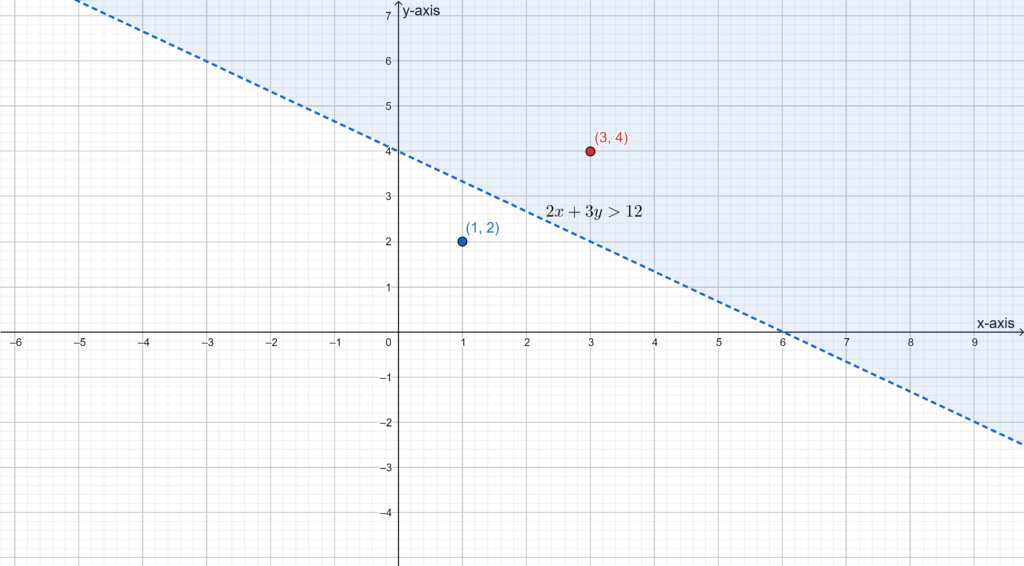
The required graph for inequality 2x + 3y > 12 is given below.

Page 34 Exercise 16 Answer
Given function: f(x) = x2 + 2x + 1
It is required to plot the graph for the given function f(x) = x2 + 2x + 1.
For this, it is required to plot a graph for x2 and shift this graph to the left 1 unit to get the required graph for f(x) = x2 + 2x + 1.
Plot the graph for x2.
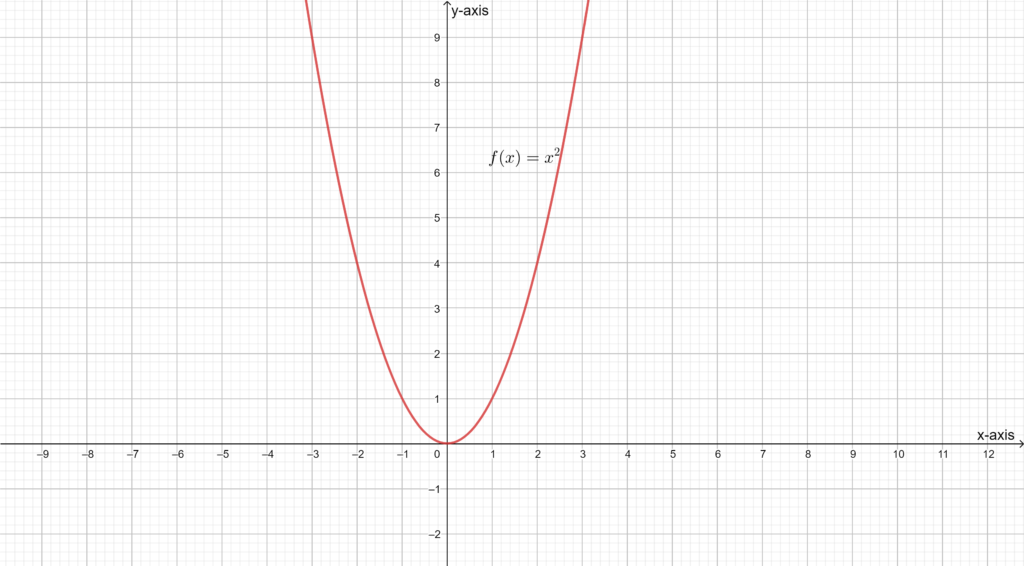
Compare x2 + 2x + 1 with expression (a+b)2 = a2 + 2ab + b2.
Thus f(x) = x2 + 2x + 1 can be written as (x+1)2.
f(x) = x2 will shifted to left 1 unit to get f(x) = (x+1)2.
Plot graph for f(x) = x2 + 2x + 1.

The required graph for f(x) = (x+1)2 is given below.

Page 35 Exercise 17 Answer
Given that a ball is thrown directly upward from a height of 10ft and an initial velocity of 32ft/s. The given equation h = −16t2 + 32t + 10 gives the height h after t seconds.
It is required to find the maximum height of the ball and the time taken by the ball to reach its maximum height.
For this, use the basic theory of velocity mentioned in the tip section to derive the linear equation and then solve it at the maximum height of the ball to find the time taken by the ball to reach its maximum height. Further, substitute the value of maximum time in the given expression to find the maximum height.
Velocity \(=\frac{d h}{d t}\)
⇒ \(V=\frac{d}{d t}\left(-16 t^2+32 t+10\right)\)
V=-32t+32
At maximum height velocity is zero
0=-32t+32
Solve for t
32t=32
⇒ \(t=\frac{32}{32}\)
t=1 sec
Substitute 1 for t in expression h= -16t²+32t+10
h=-16(1)² +32(1) +10
=-16+32+10
=26ft
The time taken by the ball to reach its maximum height is 1 sec.
The maximum height of the ball is 26ft.
Envision Algebra 1 Assessment Readiness Workbook Student Edition Chapter 2 Page 35 Exercise 18 Answer
Given: A table containing data for 7 points.
It is required to make a scatter plot of the data and estimate an equation of the line of best fit.
To make a scatter plot from the given data, locate the given points in the graph. To estimate the equation of the line, draw a line such that there are equal numbers of points above and below the line at a minimum distance then find x and y intercepts.
Draw a scatter plot.
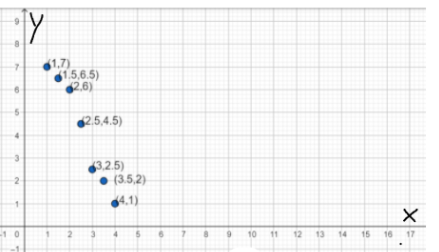
Draw a line such that there are equal numbers of points above and below the line at minimum distance then find x and y intercepts.
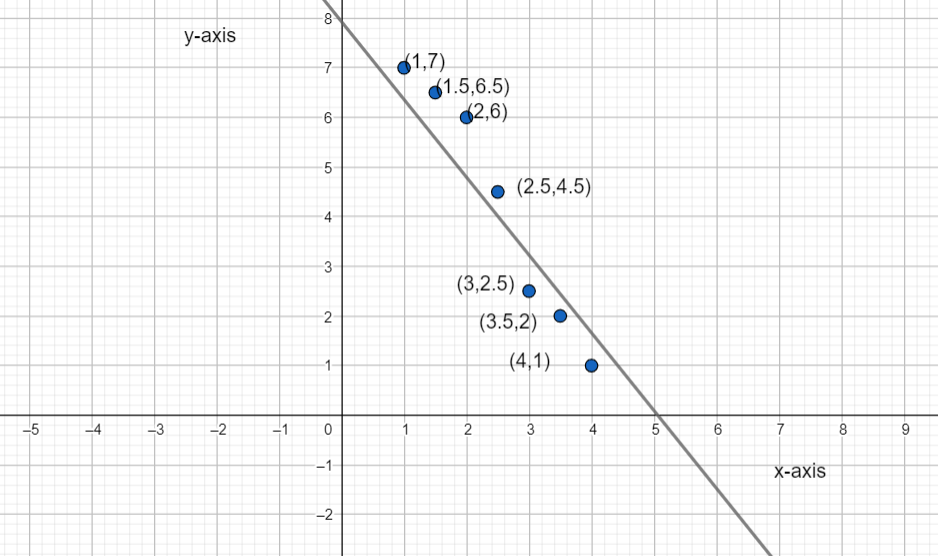
x-intercept is 5.
y-intercept is
Substitute 5 for a and 8 for b in the equation \(\frac{x}{a}+\frac{y}{b}=1\).
⇒ \(\frac{x}{5}+\frac{y}{8}\)=1
An equation of the line of best fit is \(\frac{x}{5}+\frac{y}{8}\)=1.
Page 36 Exercise 20 Answer
Given equation: 2x2 + 7x − 2 = 3
It is required to find the solutions of the equation to the nearest hundredth.
To find the solutions of the equation to the nearest hundredth, use the quadratic formula mentioned in the tip section as the given equation is a quadratic equation.
Explanation for the correct option:
Write the given formula 2x2 + 7x − 2 = 3 in the general form
Given equation: 2x²+7x-2=3
ax²+bx+c=0
2x²+7x-2=3
2x²+7x-2-3=0
2x²+7x-5=0
Substitute a=2, b=7, c=-5 in formula
Option a and e are the correct answers.
Explanation for other options:
Option b, c, d, and f do not match the values of x obtained while solving the given quadratic expression.
The solutions of the equation to the nearest hundredth are −4⋅11 and 0⋅61.
Options (A) and (E) are correct.
Page 36 Exercise 22 Answer
It is given that the inequality −2x + 2 ≤ 8.
It is required to graph the solution of the given inequality.
To graph the solution of the given inequality, find the solution of the inequality using rules for solving inequality, subtract 2 on both sides of the inequality divide by −2 reverse the sign of inequality, and graph the resulting solution.
Consider the given inequality
-2x+2≤8
Subtract 2 on both sides of the inequality
-2x+2-2≤8-2
-2x≤6
Divide by -2 on both sides and reverse the sign
⇒ \(\frac{-2 x}{-2} \geq \frac{6}{-2}\)
x≥-3
So, the graph of the solution will be,

Hence, the graph of the solution will be,

Page 36 Exercise 23 Answer
It is given that the table of points,

It is required to find which function the table represents.
To plot the points on a graph find the slope of the best-fit line and use the slope-intercept form to find the equation of the line.
Explanation for the correct option:
Plot the points on the graph,
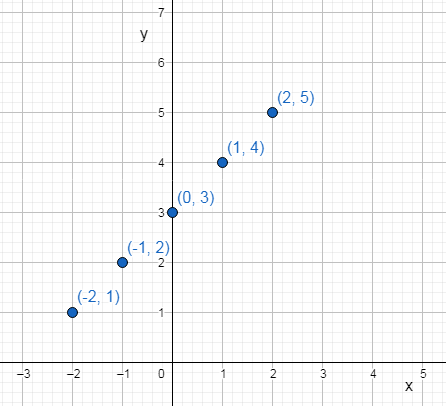
The slope of the best-fit line will be,
The slope of the best-fit line will be,
So the equation of the line in slope-intercept form will be
y=mx+c
y=x+c
Consider the point (o,3) and substitute in the slope-intercept form,
3=0+c
c=3
So, the equation will be,
y=x+3
Explanation for other options:
The equation of the line plotted using the given data does not match the equations of options a, b, and d.
Hence, the correct option will be (c).
Page 36 Exercise 24 Answer
It is given that a $220 deposit in the account that pays 3% interest compounded quarterly.
It is required to find the amount in the account after 5 years.
To find the amount in the account after 5 years, substitute 220 for P, 0.03 for r, 4 for n, and 5 for t in the compound interest formula.
Substitute 220 for P, 0.03 for r, 4 for n, and 5 for t in the formula
\(A=P\left(1+\frac{r}{n}\right)^{n t}\)Substitute p=220,r=0.03, n=4,t=5
⇒ \(\begin{aligned}
& A=220\left(1+\frac{0.03}{4}\right)^{4 \times 5} \\
& A=220\left(\frac{4.03}{4}\right)^{20} \\
& A=220(1.161) \\
& A=255.42
\end{aligned}\)
Hence, the amount in the account after 5 years will be $255.42.
Page 37 Exercise 25 Answer
It is given that the parent function y = \(\sqrt[3]{x}\).
It is required to describe the graph of y = \(4 \sqrt[3]{x}\) as a transformation of the parent function.
To describe the graph of y = \(4 \sqrt[3]{x}\) as a transformation of the parent function, plot both the curves and observe the transformation.
The graph of the parent function and given function will be,
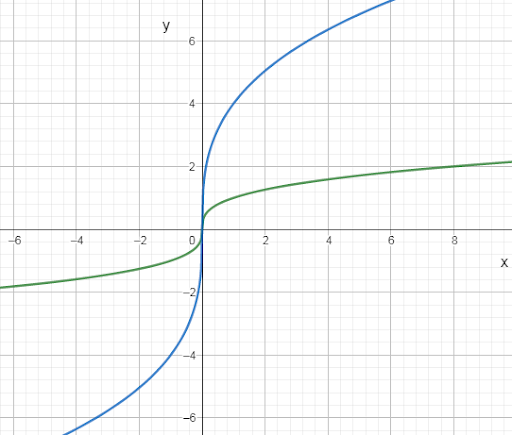
It can be observed from the graph that the parent function is stretched vertically by a factor of 4 units.
Option a indicates that the function is translated 4 units up but the graph is not shifted thus this option is not applicable.
Option b indicates that the function is compressed vertically by a factor of 4 but from the graph it is seen that there is no vertical compression thus this option is not applied.
Option d indicates the reflection along the line y = 4 but this is also not correct as the graph of the function is not a straight line.
Hence, the correct option is (c), vertical stretch by a factor of 4.
Envision Algebra 1 Student Edition Chapter 2 Practice Problems
Envision Algebra 1 Assessment Readiness Workbook Student Edition Chapter 2 Page 37 Exercise 26 Answer
It is given that linear equations are
y = 4x + 1 and
y = 3x + 5.
It is required to find the solution of the system of linear equations.
To find the solution of a system of linear equations equate the right side of both the equations as the left sides of the equations are equal. Then solve the equation for x. Substitute the value of x obtained in one of the given equations and find the value of y.
The left-hand side of both the linear equations is equal thus equation is the right-hand side of the equations.
Given Linear Equations are
y=4x+1 and
y=3x+5
4x+1=3x+5
Subtract both sides of the equation by 3x
4x+1-3x=3x+5-3x
x+1=5
Substitute 4 for x in equation y=4x+1
Thus the solution of a system of linear equations is (4,17).
Page 37 Exercise 27 Answer
It is given that the parent function is y = √x.
It is given that the graph of a transformed function is,
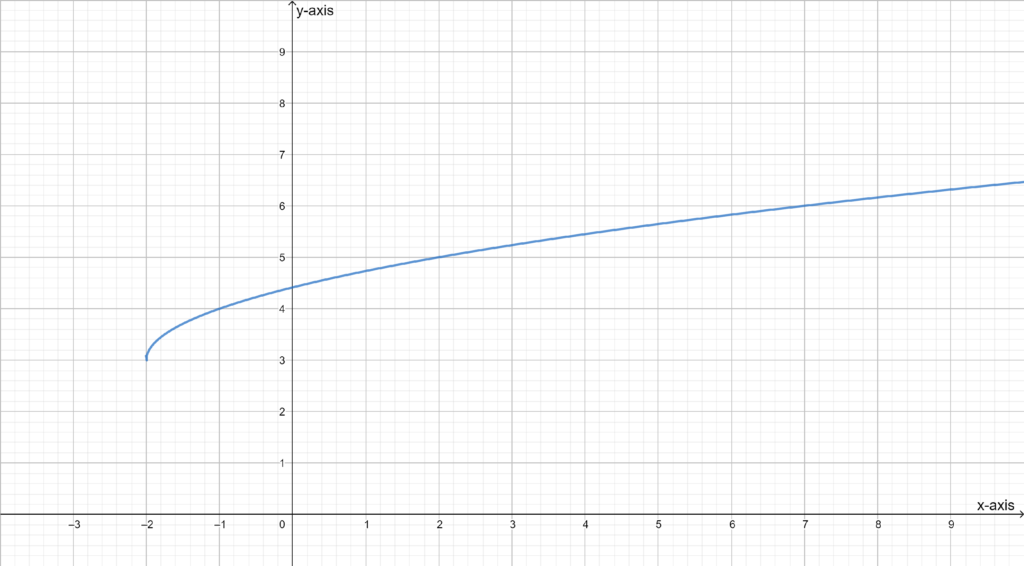
It is required to find the equation of transformation of the graph shown in the figure of the parent function y=√x.
To find the equation of transformation of the given graph of the parent function y = √x use the transformation rule :
f(x) + b shifts the function b units upward.
f(x) − b shifts the function b units downward.
f(x+b) shifts the function b units to the left.
f(x−b) shifts the function b units to the right.
Plot the graph of the parent function along with the given graph.
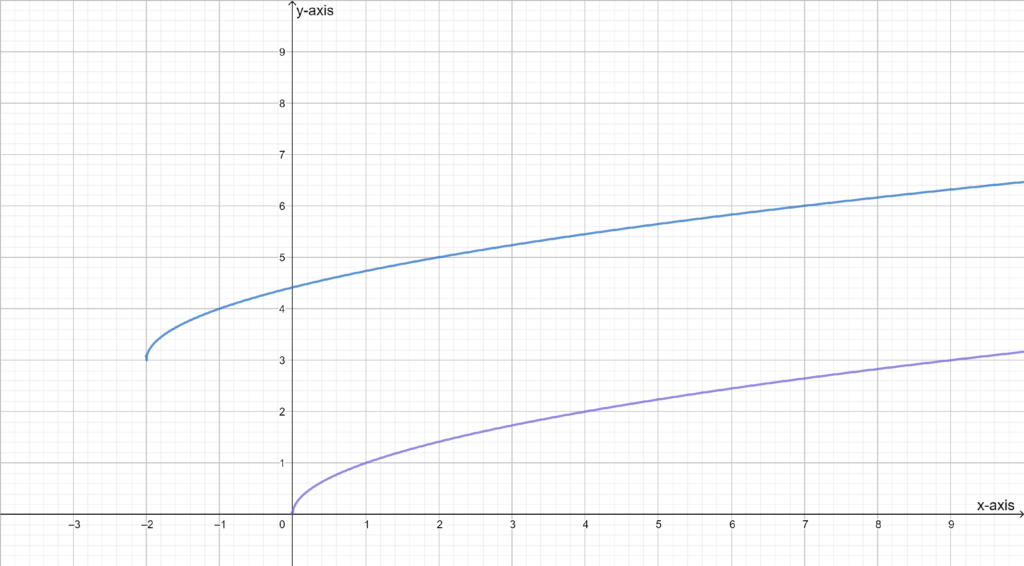
From the graph it is seen that graph of the function is shifted 2 units to the left and 3 units upward.
Thus from transition rule f(x+2)+3.
The equation for the transformation of the graph is given by \(\sqrt{x+2}+3\).
The equation for the transformation of the graph is given by \(\sqrt{x+2}+3\).
The correct answer is option (D).
Page 37 Exercise 28 Answer
It is given that the volume of a cylinder is 320π ft3 and the height is 20 ft.
It is required to find the diameter of the base of the cylinder.
To find the diameter of the base of the cylinder substitute the given values of height and volume in formula V = πr2h and solve r where r is the radius of the base. The diameter is twice the radius thus multiply the value of r by 2 to find the diameter.
Given that the volume of a cylinder is 320πft³ and height is 20ft
v=πr²h
Substitute 320π =v and h = 20
320π =πr²(20)
Divide both sides of the equation
320π = πr²(20) by 20π
⇒ \(\frac{320 \pi}{20 \pi}=\frac{\pi r^2(20)}{20 \pi}\)
16=r²
Rearrange the equation
r²=16
Square root on both sides
⇒ \(\begin{gathered}
\sqrt{r^2}=\sqrt{16} \\
r=\sqrt{4^2}
\end{gathered}\)
Since r is the length of the radius thus it cannot be negative.
Multiply radius r by 2 to find diameter.
D = 2(4)
= 8
The diameter of the cylinder is 8 ft.
Page 37 Exercise 29 Answer
It is given that table shows the preference of students in grades 9th and 10th to listen to music while studying or study in quiet.

It is required to complete the table.
It is required to find the percentage of students in grade 10th who prefer listening to music while studying.
To complete the table given simple addition is required. To find the percentage of students in grade 10th who prefer listening to music while studying divide the number of students who prefer listening to music while studying by the total number of students in grade 10 and multiply by 100.
To complete the table perform addition. Add both rows and columns and write the total result in the last row and last column.

To find the percentage of students in grade 10th who prefer listening to music while studying divide the number of students that prefer listening to music while studying by the total number of students in grade 10 and multiply by 100.
9 students in 10th grade prefer to listen to music while studying out of 40 students in 10th grade.
Thus percentage can be obtained as,
= \(\frac{9}{40} \times 100\)
= 22.5%
The complete table is,

Percent of 10th graders who listen to music while studying is 22.5%.
Page 37 Exercise 30 Answer
It is given that points and slopes are as follows:
(3,18) and (−2,8) \(\frac{1}{2}\)
(2, -5) and (-4, 7) 2
(12, -3) and (-12, 9) \(\frac{-1}{2}\)
(4,-2) and (12, 6) -2
It is required to match each pair of points to the slope of the line that passes through these points.
To match each pair of points to the slope of the line that passes through these points use formula m = \(\frac{y_2-y_1}{x_2-x_1}\) to find the slope of each line that passes through a given pair of lines and then match them with the correct slope.
Substitute 8 for y2, 18 for y1 -2 for x2 and 3 for x
⇒ \(\begin{aligned}
& m=\frac{y_2-y_1}{x_2-x_1} \\
& m=\frac{8-18}{-2-3} \\
& m=\frac{-10}{-5} \\
& m=2
\end{aligned}\)
The slope of the line that passes through a pair of points (3,18) and (2,8) is 2.
Substitute 7 for y2,-5 for y1-4 for x2 and 2 for x,
⇒ \(\begin{aligned}
& m=\frac{y_2-y_1}{x_2-x_1} \\
& m=\frac{7+5}{-4-2} \\
& m=\frac{12}{-6} \\
& m=-2
\end{aligned}\)
The slope of the line that passes through a pair of points (2,-5) and (-4,7) is -2.
Substitute 6 for y2 x-2 for y1 12 for x2,-4 in formula \(m=\frac{y_2-y_1}{x_2-x_1}\)
⇒ \(\begin{aligned}
m=\frac{y_2-y_1}{x_2-x_1} \Rightarrow m & =\frac{6+2}{12+4} \\
m & =\frac{8}{16} \\
m & =\frac{1}{2}
\end{aligned}\)
Substitute 9 for y2-3 for y1 -12 for x
⇒ \(\begin{aligned}
m=\frac{y_2-y_1}{x_2-x_1} \Rightarrow m & =\frac{9+3}{-12-12} \\
m & =\frac{12}{-24} \\
m & =\frac{-1}{2}
\end{aligned}\)
The slope of the line that passes through a pair of points (12,-3)(-12,9) is \(\frac{-1}{2}\)
The slope of the line that passes through
The slope of the line that passes through a pair of points (3,18) and (−2,8) is 2.
The slope of the line that passes through a pair of points (2,−5) and (−4,7) is −2.
The slope of the line that passes through a pair of points (12,−3) and (−12,9) is \(\frac{1}{-2}\).
The slope of the line that passes through the pair of points (-4, -2) and (12, 6) is \(\frac{1}{2}\).
Envision Algebra 1 Assessment Readiness Workbook Student Edition Chapter 2 Page 38 Exercise 31 Answer
It is given that the age of members of the chess club is 13,15,22,23,35,38,49,56. A new member whose age is 48 years joins the club.
It is required to describe how the mean, median, mode, and range of the ages of club members are affected after joining of new member.
To describe how the mean, median, mode, and range of the ages of club members are affected after joining of new member first find the mean, median, mode, and range of existing club members then find the mean, median, mode, and range of existing members along with new member and see the changes in the values.
Data for old club members: 13,15,22,23,35,38,49,56
The mean is the sum of all the ages divided by no. of members.
Mean ,= \(\frac{13+15+22+23+35+38+49}{8}\)
Mean = \(\frac{251}{8}\)
Mean = 31.375
Since total number of outcomes are even thus median is given by formula \(\frac{\left(\frac{n}{2}\right)^{t h} \text { term }+\left(\frac{n}{2}+1\right)^{t h} \text { term }}{2}\) where n the total number of outcomes.
Median = \(\frac{\left(\frac{8}{2}\right)^{\text {th }} \operatorname{term}+\left(\frac{8}{2}+1\right)^{\text {th }} \text { term }}{2}\)
Median= \(\frac{4^{\text {th }} \text { term }+5^{\text {th }} \text { term }}{2}\)
From the data, it is seen that the fourth term is 23 and the fifth term is 35 thus simplifying to obtain the median.
median = \(\frac{23+35}{2}\)
= \(\frac{58}{2}\)
= 29
Mode for the given data does not exist because each value occurs only once in the data.
The range of the data is the highest value subtracted by the lowest value of the data set.
From the data, it is seen that the highest value is 56 and the lowest value is 13 thus,
Range = 56 − 13
Data for old club members along with new joining: 13,15,22,23,35,38,48,49,56
The mean is the sum of all the ages divided by no. of members.
mean = \(\frac{13+15+22+23+35+38+48+49+56}{9}\)
= \(\frac{251}{9}\)
= 33.23
since the total number of outcomes is odd the median is given by the formula \(\left(\frac{n+1}{2}\right)^{t h} \text { term }\) where n is the total number of outcomes.
median = \(\left(\frac{9+1}{2}\right)^{t h} \text { term }\)
= 5th term
From the data it is seen that the fifth term is 35 thus median will be 35.
Mode for the given data does not exist because each value occurs only once in the data.
The range of the data is the highest value subtracted by the lowest value of the data set.
From the data, it is seen that the highest value is 56 and the lowest value is 13 thus,
Range = 56 − 13
From the above data, it is concluded that the mean and median are increased after joining of new member whereas the mode and range of the data remain the same.
It is concluded that the mean and median are increased after joining of new member whereas the mode and range of the data remain the same.
Page 38 Exercise 33 Answer
It is given that the measure of angle A is three times the measure of angle B and the measure of angle C is one-half times the measure of angle B.
It is required to find a measure of all the three angles.
To find a measure of all three angles use the triangle sum property. The sum of all three angles of an obtuse triangle is 180°.
Let the measure of angle B be x.
Use the triangle sum theorem to form an equation as the measure of angle A is three times the measure of angle B and the measure of angle C is one-half times the measure of angle B.
Solve the expression
⇒ \(x^0+3 x^{\circ}+\frac{1}{2} x^0=180^{\circ}\)
Mathematical operations and find the value of x
⇒ \(\begin{aligned}
& x^{\circ}+3 x^{\circ}+\frac{1}{2} x^{\circ}=180^{\circ} \\
& \frac{9}{2} x^{\circ}=180^{\circ}
\end{aligned}\)
Multiply both sides of the expression
⇒ \(\begin{aligned}
& \frac{9}{2} x^{\circ}=180^{\circ} \text { by } \frac{2}{9} \\
& \frac{9}{2} x^{\circ} \times \frac{2}{9}=180^{\circ} \times \frac{2}{9}
\end{aligned}\)
x°=40°
Thus the measure of angle B is 40°.
To find a measure of angle A multiply the measure of B by 3 and simplify.
= 3(40°)
= 120°
To find a measure of angle C divide the measure of B by 2 and simplify.
= \(\frac{40^{\circ}}{2}\)
= 20°
The measure of angle A is 120°, the measure of angle B is 40°, and the measure of angle C is 20°.
Envision Algebra 1 Assessment Readiness Workbook Student Edition Chapter 2 Page 38 Exercise 34 Answer
It is given that the function is f(x) = 2x2 − 6x + 4.
It is required to find zeros of the given function.
To find zeros of the function equate the function to 0. Then split the middle term into two terms such that the sum of those two terms is equal to the middle term and the product of those two terms is equal to the first and last term.
Equate the function f(x) = 2x2 − 6x + 4 to 0.
Given f(x)= 2x²-6x+4=0
2x²-2x-4x+4=0
2x(x-1)-4(x-1)=0
(2x-4)(x-1)=0
Either (2x-4) is equal to o or (x-1) is equal to 0
Let 2x-4=0
Add 4 on both sides
2x-4+4=0+4
2x=4
Divide both sides into 2
⇒ \(\begin{aligned}
\frac{2 x}{2} & =\frac{4}{2} \\
x & =2
\end{aligned}\)
Let x=1=0
Add 1 on both sides
x-1+1=0+1
x=1
Zeros of the function f(x) = 2x2 − 6x + 4 are 2 and 1.
Page 39 Exercise 35 Answer
It is given that total number of coins is 30 and the total cost is $2.10.
It is required to write a system of equations and find the number of each type of coin.
To write a system of equations use the given condition and fact that a nickel worth $0.05 and a dime worth $0.10. Then solve the two equations to find the number of each type of coin.
Let x be the number of nickel coins and y be the number of dime coins.
By the given condition that the total number of coins is 30 the equation formed is x + y = 30.
Then equation is formed by another condition total cost is $2.10 and the fact that a nickel is worth $0.05 and a dime worth $0.10 is 0.05x + 0.10y = 2.10.
Given 0.05+0.10y=2.10-1
rearrange equation x+y=30
y=30-x
Substitute y =30-x in the equation
The system of equations used to determine the number of each type of coin are:
x + y = 30 and
0.05x + 0.10y = 2.10
There are 18 nickel coins and 12 coins of dime.
Envision Algebra 1 Chapter 2 Step-By-Step Solutions
Envision Algebra 1 Assessment Readiness Workbook Student Edition Chapter 2 Page 39 Exercise 36 Answer
It is given that the piecewise function is:
f(x) = \(\left\{\begin{array}{l}
2 x-2 \text { if } x<-2 \\
1.5 x \text { if }-2 \leq x<4 \\
2 \text { if } x>4
\end{array}\right.\)
It is required to plot the given piecewise function.
Graph the piece-wise function
f(x) = \(\left\{\begin{array}{l}
2 x-2 \text { if } x<-2 \\
1.5 x \text { if }-2 \leq x<4 \\
2 \text { if } x>4
\end{array}\right.\) where
the x-axis represents different values of x and the y-axis represents the values of the function obtained while substituting the values of x.
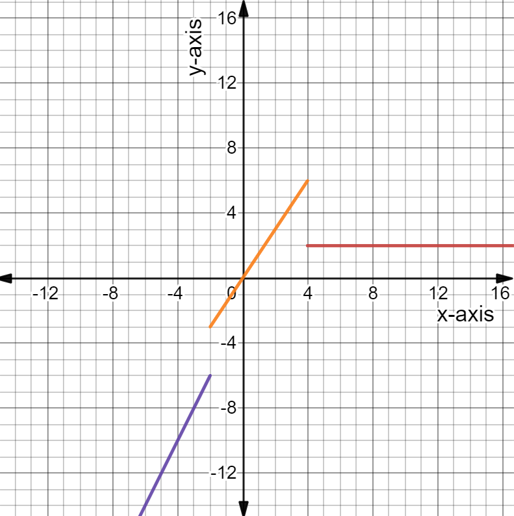
The graph of the piece wise function f(x) = \(\left\{\begin{array}{l}
2 x-2 \text { if } x<-2 \\
1.5 x \text { if }-2 \leq x<4 \\
2 \text { if } x>4
\end{array}\right.\) is as follows,

It is given that the piecewise function is
f(x) = \(\left\{\begin{array}{l}
2 x-2 \text { if } x<-2 \\
1.5 x \text { if }-2 \leq x<4 \\
2 \text { if } x>4
\end{array}\right.\)
It is required to find the domain and range of the function.
To find the domain and range of the function use the definition of range and domain.
The first condition of function shows that it is given that function exists at every point x < −2.
The second condition shows that the function exists at point −2 also.
The third condition shows that the function exists at every point where x>4.
This domain can be written as (−∞,4)∪(4,∞).
The range is a set of all output values. Thus range of functions is the entire real line.
Domain of the function
f(x) = \(\left\{\begin{array}{l}
2 x-2 \text { if } x<-2 \\
1.5 x \text { if }-2 \leq x<4 \\
2 \text { if } x>4
\end{array}\right.\) is
(−∞,4)∪(4,∞) and range is (−∞, ∞).
It is given that the piecewise function is
f(x) = \(\left\{\begin{array}{l}
2 x-2 \text { if } x<-2 \\
1.5 x \text { if }-2 \leq x<4 \\
2 \text { if } x>4
\end{array}\right.\).
It is required to find the interval on which the function is increasing or decreasing.
To find the interval on which function is increasing or decreasing see the graph of the function and use the definition of increasing and decreasing functions to find the interval.
The graph of the function
f(x) = \(\left\{\begin{array}{l}
2 x-2 \text { if } x<-2 \\
1.5 x \text { if }-2 \leq x<4 \\
2 \text { if } x>4
\end{array}\right.\) is,
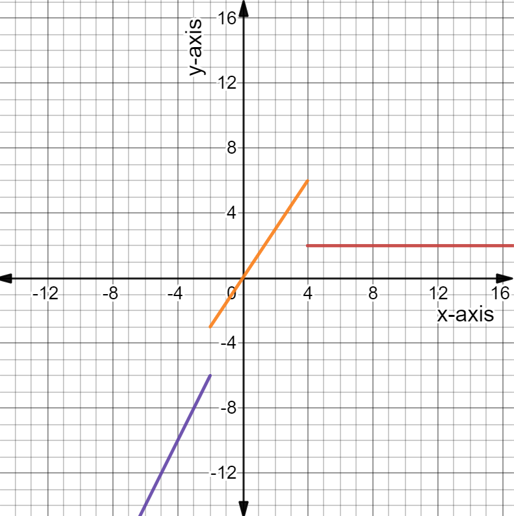
It is concluded from the graph that the value of the function decreases as the value of x decreases over the interval (−∞,−2).
It is concluded from the graph that the value of the function is increasing as the value of x increases over the interval [−2,4).
It is concluded that over the interval (4,∞) the value of the function remains constant as the value of x increases over the interval (-2, 4).
It is concluded that over the interval (4, ∞) the value of the function remains constant as the value of x increases.
It is concluded from the graph that the value of the function is decreasing as the value of x decreases over the interval (−∞,−2).
It is concluded from the graph that the value of the function is increasing as the value of x increases over the interval [−2,4).
It is concluded that over the interval (4,∞) the value of the function remains constant as the value of x increases over the interval (-2, 4).
It is concluded that over the interval (4, ∞) the value of the function remains constant as the value of x increases.
How To Solve Envision Algebra 1 Chapter 2 Questions
Page 40 Exercise 1 Answer
It is given that the initial height of a baseball is 5ft, and the initial speed is 60ft/s.
It is required to find an equation that represents the ball’s path and graph the equation.
To find an equation that represents the balls path and graph the equation substitute the given values in the formula y = \(-\frac{g}{V^2} x^2+x+y_0\) and simplify to form an equation in x and y. Then use the graphing tool to plot the graph of the function.
Substitute 5 for y0, 60 for V and 32 for g in formula y = \(-\frac{g}{V^2} x^2+x+y_0\) and simplify.
y = \(-\frac{32}{(60)^2} x^2+x+5\)
y = -0.0089x2 + x + 5
plot the graph of a function
y = -0.0089x2 + x + 5 where the x-axis represents the horizontal distance traveled by the baseball and the y-axis represents the height of the baseball.

The graph of the function along with Felipe’s position is,
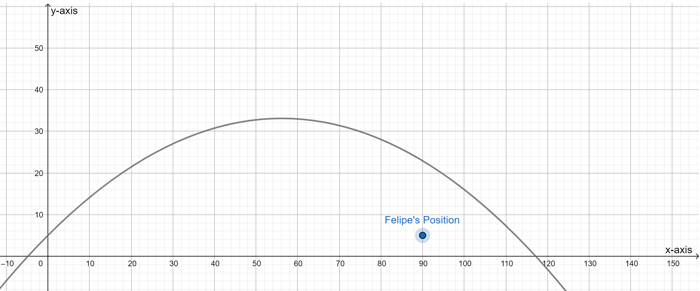
From the graph it is seen that ball passed the Felipe’s position thus the ball did not land in Felipe’s gloves.
The equation that represents the ball path is y = −0.0089x2 + x + 5.
Graph that represents the equation y = −0.0089x2 + x + 5 is as follows,
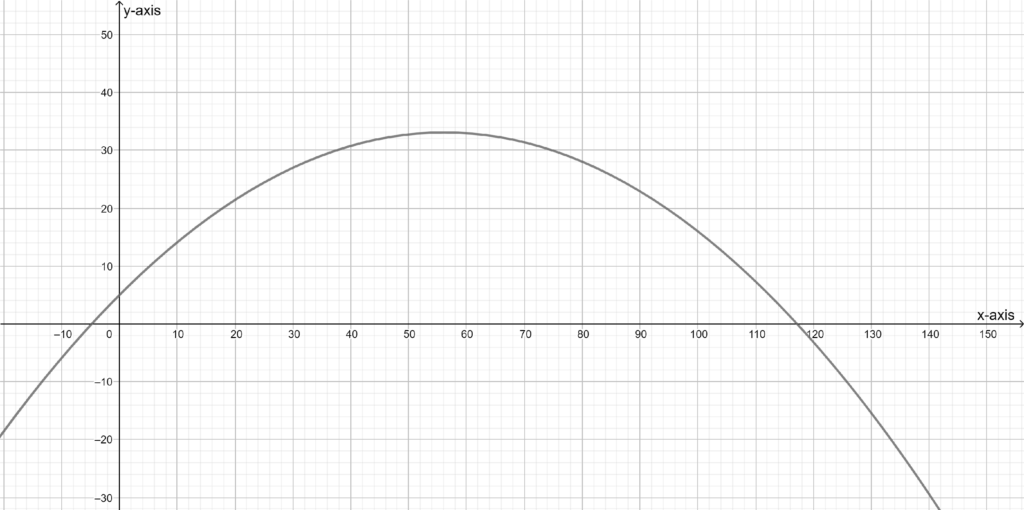
From the graph it is seen that ball passed the Felipe’s position thus the ball did not land in Felipe’s gloves.
It is given that the initial height of a baseball is 5ft, and the initial speed is 60ft/s.
It is required to find an equation that represents the ball’s path and graph the equation.
To find an equation that represents the ball path and graph the equation substitute the given values in the formula y = \(-\frac{g}{V^2} x^2+x+y_0\) to find the value of x. Thus the point obtained is the point that lies on the ball’s path.
⇒ \(y=\frac{-9}{v^2} x^2+x+y_0\)
Substitute y=5ft,y0=5ft,v=60ftls,g=32ftls²
⇒ \(5=-\frac{32}{(60)^2}\left(x^2\right)+90+5\)
⇒ \(\begin{aligned}
& 0=\frac{-32}{3600} \times x^2+x \\
& 0=-\frac{2 x^2}{225}+x
\end{aligned}\)
Rearrange equation \(\frac{2 x^2}{225}-x=0\)
2x²-225x=0
Take x as a common factor
x(2x-225)=0
Let x = 0.
Thus one point that lies on the ball’s path so that Felipe catches the ball is(0,5) but this is not possible as the ball does not travel any horizontal distance.
Let 2x-225=0
Add 225 on both sides
2x-225+225=0+225
Divide 2 on both sides
⇒ \(\frac{2 x}{2}=\frac{225}{2}\)
x=112.5
Thus the point that lies on the ball’s path so that Felipe catches the ball is (112.5,5).
The points that lie on the ball’s path so that Felipe catches the ball is (112.5,5) because it is given that Felipe is 5ft above the ground so the value of y is substituted as 5ft in the formula y = \(-\frac{g}{V^2} x^2+x+y_0\) with given initial conditions.
It is given that the answer to part b is to be used.
It is required to find an equation that describes the initial height and initial speed for which a friend catches the ball.
To find an equation that describes the initial height and initial speed for which a friend catches the ball substitute the point (112.5,5) for (x,y) in
\(y=\frac{-g}{v^2} x^2+x+y_0\)Substitute (112.5,5) for(x,y)
⇒ \(5=\frac{-9}{v^2}(112.5)^2+(112.5)+y_0\)
⇒ \(\begin{aligned}
& 5-112.5=\frac{-405000}{v^2}+y_0 \\
& -107.5+\frac{405000}{v^2}=y_0
\end{aligned}\)
Thus the equation that describes initial height and initial speed is
⇒ \(y_0=\frac{405000}{V^2}-107.5\).
The equation that describes initial height and initial speed is \(y_0=\frac{405000}{V^2}-107.5\).
There is only one possible equation to describe the initial height and initial speed of the ball.
It is given that a friend catches the ball.
It is required to find the initial height and initial speed for which a friend catches the ball.
To find the initial height and initial speed for which a friend catches the ball, use the hit and trial method and substitute values of V to find values of y0 in the equation
⇒ \(y_0=\frac{405000}{V^2}-107.5\) and check which value is possible.
Let v=90
Substitute 90 for v in the equation
⇒ \(\begin{aligned}
y_0 & =\frac{405000}{v^2}-107.5 \\
y_0 & =\frac{405000}{(90)^2}-107.5 \\
& =50-107.5 \\
& =-57.5
\end{aligned}\)
But height cannot be negative thus substitution wrong
Let v=60
substitute 60 for v in the equation
⇒ \(\begin{aligned}
y_0 & =\frac{405000}{(60)^2}-107.5 \\
y_0 & =112.5-107.5 \\
& =5
\end{aligned}\)
Thus the initial height and initial speed of the ball are 5 and 60 respectively.
Thus the initial height and initial speed of the ball are 5 and 60 respectively.
